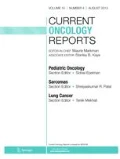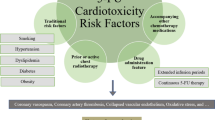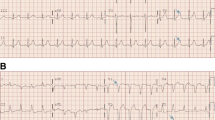Abstract
Fluoropyrimidines—5-fluorouracil (5-FU) and capecitabine—have been implicated as cardiotoxic chemotherapy agents. This rare, albeit potentially serious toxicity has been described in nearly four decades of case reports, case series, and in vitro modeling; however, there is a paucity in clinical trials and prospective analyses focused on cardioprotective strategies and cardiotoxic surveillance of these agents. While much attention has focused on the well-known cardiac toxicity of anthracyclines and monoclonal antibody agents such as trastuzumab, fluoropyrimidines remain one of the most common causes of chemotherapy-associated cardiotoxicity. The introduction of capecitabine, an oral prodrug of 5-FU, has made the treatment of solid tumors more convenient along with a subsequent rise in documented cardiotoxic cases. This review discusses the symptomatology, clinical manifestations, and proposed molecular mechanisms that attempt to describe the heterogeneous spectrum of fluoropyrimidine-induced cardiotoxicity. Four case examples showcasing the varied manifestations of cardiotoxicity are presented. Finally, several proposed management strategies for cardiotoxicity and post-hospital course precautions are discussed.






Similar content being viewed by others
References
Papers of particular interest, published recently, have been highlighted as: • Of importance •• Of major importance
Ansfield F, Klotz J, Nealon T, et al. A phase III study comparing the clinical utility of four regimens of 5-fluorouracil: a preliminary report. Cancer. 1977;39:34–40.
Lokich JJ. Infusional 5-FU: historical evolution, rationale, and clinical experience. Oncology. 1998;12:19–22.
U.S. Cancer Statistics Working Group. United States Cancer Statistics: 1999–2012 incidence and mortality web-based report. Atlanta: U.S. Department of Health and Human Services, Centers for Disease Control and Prevention and National Cancer Institute; 2015.
Heidelberger C, Chaudhuri NK, Danneberg P, et al. Fluorinated pyrimidines, a new class of tumour-inhibitory compounds. Nature. 1957;179(4561):663–6.
Cohen SS, Flaks JG, Barner HD, Loeb MR, Lichtenstein J. The mode of action of 5-fluorouracil and its derivatives. Proc Natl Acad Sci U S A. 1958;44(10):1004–12.
Longley DB, Harkin DP, Johnston PG. 5-fluorouracil: mechanisms of action and clinical strategies. Nat Rev Cancer. 2003;3(5):330–8.
Moertel CG, Fleming TR, Macdonald JS, et al. Levamisole and fluorouracil for adjuvant therapy of resected colon carcinoma. N Engl J Med. 1990;322:352–8.
Van Cutsem E, Hoff PM, Blum JL, Abt M, Osterwalder B. Incidence of cardiotoxicity with the oral fluoropyrimidine capecitabine is typical of that reported with 5-fluorouracil. Ann Oncol. 2002;13(3):484–5.
Hoff PM, Ansari R, Batist G, et al. Comparison of oral capecitabine versus intravenous fluorouracil plus leucovorin as first-line treatment in 605 patients with metastatic colorectal cancer: results of a randomized phase III study. J Clin Oncol. 2001;19:2282–92.
Miwa M, Ura M, Nishida M, et al. Design of a novel oral fluoropyrimidine carbamate, capecitabine, which generates 5-fluorouracil selectively in tumours by enzymes concentrated in human liver and cancer tissue. Eur J Cancer. 1998;34:1274–81.
Malet-Martino M, Jolimaitre P, Martino R. The prodrugs of 5-fluorouracil. Curr Med Chem Anticancer Agents. 2002;2(2):267–310.
Mikhail SE, Sun JF, Marshall JL. Safety of capecitabine: a review. Expert Opin Drug Saf. 2010;9(5):831–41.
Anand A. Fluorouracil cardiotoxicity. Ann Pharmacother. 1994;28:374.
Akhtar S, Salim K, Bano Z. Symptomatic cardiotoxicity with high dose 5-fluorouracil infusion: a prospective study. Oncology. 1993;50:441.
Wacker A, Lersch C, Scherpinski U, Reindl L, Seyfarth M. High incidence of angina pectoris in patients treated with 5-fluorouracil: a planned surveillance study with 102 patients. Oncology. 2003;65(2):108–12.
Lamberti M, Porto S, Zappavigna S, et al. A mechanistic study on the cardiotoxicity of 5-fluorouracil in vitro and clinical and occupational perspectives. Toxicol Lett. 2014;227(3):151–6.
Polk A, Vaage-Nilsen M, Vistisen K, Nielsen DL. Cardiotoxicity in cancer patients treated with 5-fluorouracil or capecitabine: a systematic review of incidence, manifestations and predisposing factors. Cancer Treat Rev. 2013;39(8):974–84. This systematic review offers a meta-analysis of predisposing risk factors for cardiotoxicity and provides the best estimate to date of clinical and subclinical event rates.
Meydan N, Kundak I, Yavuzsen T, et al. Cardiotoxicity of de Gramont’s regimen: incidence, clinical characteristics and long-term follow-up. Jpn J Clin Oncol. 2005;35(5):265–70.
Tsavaris N, Kosmas C, Vadiaka M, et al. Cardiotoxicity following different doses and schedules of 5-fluorouracil administration for malignancy—a survey of 427 patients. Med Sci Monit. 2002;8(6):151–7.
Schöber C, Papageorgiou E, Harstrick A, et al. Cardiotoxicity of 5-fluorouracil in combination with folinic acid in patients with gastrointestinal cancer. Cancer. 1993;72(7):2242–7.
Kosmas C, Kallistratos MS, Kopterides P, et al. Cardiotoxicity of fluoropyrimidines in different schedules of administration: a prospective study. J Cancer Res Clin Oncol. 2008;134(1):75–82.
De Forni M. Cardiotoxicity of high-dose continuous infusion fluorouracil: a prospective clinical study. J Clin Oncol. 1992;10(11):1795–801.
Khan MA, Masood N, Husain N, et al. A retrospective study of cardiotoxicities induced by 5-fluouracil (5-FU) and 5-FU based chemotherapy regimens in Pakistani adult cancer patients at Shaukat Khanum Memorial Cancer Hospital & Research Center. J Pak Med Assoc. 2012;62:430–4.
De Gramont A, Bosset JF, Milan C, et al. Randomized trial comparing monthly low-dose leucovorin and fluorouracil bolus with bimonthly high-dose leucovorin and fluorouracil bolus plus continuous infusion for advanced colorectal cancer: a French intergroup study. J Clin Oncol. 1997;15(2):808–15.
Jensen SA, Sørensen JB. Risk factors and prevention of cardiotoxicity induced by 5-fluorouracil or capecitabine. Cancer Chemother Pharmacol. 2006;58(4):487–93.
Oztop I, Gencer M, Okan T, et al. Evaluation of cardiotoxicity of a combined bolus plus infusional 5-fluorouracil/folinic acid treatment by echocardiography, plasma troponin I level, QT interval and dispersion in patients with gastrointestinal system cancers. Jpn J Clin Oncol. 2004;34(5):262–8.
Meyer CC, Calis KA, Burke LB, Walawander CA, Grasela TH. Symptomatic cardiotoxicity associated with 5-fluorouracil. Pharmacotherapy. 1997;17(4):729–36.
Jeremic B, Jevremovic S, Djuric L, Mijatovic L. Cardiotoxicity during chemotherapy treatment with 5-fluorouracil and cisplatin. J Chemother. 1990;2(4):264–7.
Ng M, Cunningham D, Norman AR. The frequency and pattern of cardiotoxicity observed with capecitabine used in conjunction with oxaliplatin in patients treated for advanced colorectal cancer (CRC). Eur J Cancer. 2005;41:1542–6.
Jakubowski AA, Kemeny N. Hypotension as a manifestation of cardiotoxicity in three patients receiving cisplatin and 5-fluorouracil. Cancer. 1988;62(2):266–9.
Kuzel T, Esparaz B, Green D, Kies M. Thrombogenicity of intravenous 5-fluorouracil alone or in combination with cisplatin. Cancer. 1990;65(4):885–9.
Robben NC, Pippas AW, Moore JO. The syndrome of 5-fluorouracil cardiotoxicity. An elusive cardiopathy. Cancer. 1993;71:493–9.
Raja W, Mir MH, Ahmad I, et al. Cisplatin induced paroxysmal supraventricular tachycardia. Indian J Med Paediatr Oncol. 2013;34(4):330–2.
Kushner BH, LaQuaglia MP, Wollner N, et al. Desmoplastic small round-cell tumor: prolonged progression-free survival with aggressive multimodality therapy. J Clin Oncol. 1996;14(November 2014):1526–31.
He D, Zhang Q, Wang J. Resveratrol protects against cisplatin-induced cardiotoxicity by alleviating oxidative damage. Cancer Biother Radiopharm. 2009;24(6):675–80.
Bovelli D, Plataniotis G, Roila F. Cardiotoxicity of chemotherapeutic agents and radiotherapy-related heart disease: ESMO clinical practice guidelines. Ann Oncol. 2010;21:277–82.
Mozdzanowska D, Woźniewski M. Review. Radiotherapy and anthracyclines—cardiovascular toxicity. Contemp Oncol (Pozn). 2015;2:93–7.
Koca D, Salman T, Unek IT, et al. Clinical and electrocardiography changes in patients treated with capecitabine. Chemotherapy. 2011;57(5):381–7.
Labianca R, Beretta G, Clerici M, Fraschini P, Luporini G. Cardiac toxicity of 5-FU: a study of 1,083 patients. Tumori. 1982;68:505–10.
Ceyhan C, Meydan N, Barutca S, et al. Influence of high-dose leucovorin and 5-fluorouracil chemotherapy regimen on P wave duration and dispersion. J Clin Pharm Ther. 2004;29(3):267–71.
Rezkalla S, Kloner R, Ensley J, et al. Continuous ambulatory ECG monitoring during flurouracil therapy: a prospective study. J Clin Oncol. 1989;7:509–14.
Sorrentino MF, Kim J, Foderaro AE, Truesdell AG. 5-fluorouracil induced cardiotoxicity: review of the literature. Cardiol J. 2012;19(5):453–8.
Alter P, Herzum M, Soufi M, Schaefer JR, Maisch B. Cardiotoxicity of 5-fluorouracil. Cardiovasc Hematol Agents Med Chem. 2006;4(1):1–5.
Rateesh S, Shekar K, Naidoo R, Mittal D, Bhaskar B. Use of extracorporeal membrane oxygenation for mechanical circulatory support in a patient with 5-fluorouracil induced acute heart failure. Circ Hear Fail. 2015;8(2):381–3.
Höllriegel R, Fischer J, Schuler G. Early extracorporeal membrane oxygenation support for 5-fluorouracil-induced acute heart failure with cardiogenic shock. Hear Views. 2014;15(1):26.
David JS, Gueugniaud PY, Hepp A, Gaussorgues P, Petit P. Severe heart failure secondary to 5-fluorouracil and low-doses of folinic acid: usefulness of an intra-aortic balloon pump. Crit Care Med. 2000;28(10):3558–60.
Tsavaris N, Kosmas C, Vadiaka M, et al. 5-fluorouracil cardiotoxicity is a rare, dose and schedule-dependent adverse event: a prospective study. J BUON. 2005;10(2):205–11.
Fontanella C, Aita M, Cinausero M, Aprile G, Baldin MG, Dusi V. Capecitabine-induced cardiotoxicity : more evidence or clinical approaches to protect the patients’ heart? Onco Targets Ther. 2014;7:1783–91. This case report and review focuses on the cardiotoxicity of capecitabine as it becomes increasingly more used in clinical practice.
Cardinale D, Colombo A, Colombo N. Acute coronary syndrome induced by capecitabine therapy. Can J Cardiol. 2006;22(3):251–3.
Frickhofen N, Beck FJ, Jung B, Fuhr HG, Andrasch H, Sigmund M. Capecitabine can induce acute coronary syndrome similar to 5-fluorouracil. Ann Oncol. 2002;13(5):797–801.
Farina A, Malafronte C, Valsecchi MA, Achilli F. Capecitabine-induced cardiotoxicity: when to suspect? How to manage? A case report. J Cardiovasc Med. 2009;10(9):722–6.
Shoemaker LK, Arora U, Max C, Lima SR. 5-Fluorouracil-induced coronary vasospasm. Cancer Control. 2004;11(1):1–4.
Mosseri M, Fingert HJ, Varticovski L, Chokshi S, Isner JM. In vitro evidence that myocardial ischemia resulting from 5-fluorouracil chemotherapy is due to protein kinase C-mediated vasoconstriction of vascular smooth muscle. Cancer Res. 1993;53:3028–33.
Eskilsson J, Albertsson M. Failure of preventing 5-fluorouracil cardiotoxicity by prophylactic treatment with verapamil. Acta Oncol. 1990;29(8):1001–3.
Cwikiel M, Albertsson M, Eskilsson J, Stavenow L. The influence of 5-fluorouracil and methotrexate on vascular endothelium. An experimental study using endothelial cells in culture. Ann Oncol. 1996;7:731–7.
Cwikiel M, Albertsson M, Eskilsson J, Stjernqvist U, Wieslander JB. The appearance of endothelium in small arteries after treatment with 5-fluorouracil. An electron microscopic study of its late effects in rabbits. Scan Microsc. 1996;10(3):805–20.
Cwikiel M, Zhang B, Eskilsson J, Wieslander JB, Albertsson M. The influence of 5-fluorouracil on the endothelium in small arteries. A scanning and transmission electron microscopic study in rabbits. Scan Microsc. 1995;9(2):561–76.
Kinhult S, Albertsson M, Eskilsson J, Cwikiel M. Antithrombotic treatment in protection against thrombogenic effects of 5-fluorouracil on vascular endothelium: a scanning microscopy evaluation. Scanning. 2001;23(1):1–8.
Jensen SA, Sørensen JB. 5-Fluorouracil-based therapy induces endovascular injury having potential significance to development of clinically overt cardiotoxicity. Cancer Chemother Pharmacol. 2012;69(1):57–64.
Focaccetti C, Bruno A, Magnani E, et al. Effects of 5-fluorouracil on morphology, cell cycle, proliferation, apoptosis, autophagy and ROS production in endothelial cells and cardiomyocytes. PLoS One. 2015;10(2):e0115686. This mechanistic paper demonstrates that fluoropyrimidines may be cytotoxic to two key cell types of the cardiovascular system, cardiomyocytes and endothelial cells. Its cytotoxic mechanism may be mediated through the production of reactive oxygen species.
Kinhult S, Albertsson M, Eskilsson J, Cwikiel M. Effects of probucol on endothelial damage by 5-fluorouracil. Acta Oncol. 2003;42(4):304–8.
Muneoka K, Shirai Y, Yokoyama N, et al. 5-fluorouracil cardiotoxicity induced by alpha-fluoro-beta-alanine. Int J Clin Oncol. 2005;10:441–3.
Lemaire L, Malet-Martino MC, de Forni M, Martino R, Lasserre B. Cardiotoxicity of commercial 5-fluorouracil vials stems from the alkaline hydrolysis of this drug. Br J Cancer. 1992;66(1):119–27.
Polk A, Vistisen K, Vaage-Nilsen M, Nielsen DL. A systematic review of the pathophysiology of 5-fluorouracil-induced cardiotoxicity. BMC Pharmacol Toxicol. 2014;15:47. A systematic review of fluoropyrimidine-induced cardiotoxic pathophysiology that appears to suggest toxicity occurs through a multifactorial process instead of a single underlying mechanism.
Becker K, Erckenbrecht J, Haussinger D, Frieling T. Cardiotoxicity of the antiproliferative compound fluorouracil. Abstr Drugs. 1999;57(4):475–84.
Jensen SA, Hasbak P, Mortensen J, Sørensen JB. Fluorouracil induces myocardial ischemia with increases of plasma brain natriuretic peptide and lactic acid but without dysfunction of left ventricle. J Clin Oncol. 2010;28(36):5280–6.
McGlinchey PG, Webb ST, Campbell NP. 5-Fluorouracil-induced cardiotoxicity mimicking myocardial infarction: a case report. BMC Cardiovasc Disord. 2001;1:3.
Lim SH, Wilson SM, Hunter A, Hill J, Beale P. Case report. Takotsubo cardiomyopathy and 5-fluorouracil : getting to the heart of the matter. Case Rep Oncol Med. 2013;2013:1–5.
Stewart T, Pavlakis N, Ward M. Cardiotoxicity with 5-fluorouracil and capecitabine: more than just vasospastic angina. Intern Med J. 2010;40(4):303–7.
Holubec LJ, Topolcan O, Finek J, Salvet J, Svoboda T. Dynamic monitoring of cardio-specific markers and markers of thyroid gland function in cancer patients—a pilot study. Oncology. 2007;1886:1883–6.
Curigliano G, Cardinale D, Suter T, et al. Cardiovascular toxicity induced by chemotherapy, targeted agents and radiotherapy: ESMO Clinical Practice Guidelines. Ann Oncol. 2012;23:155–66.
Papadopoulos CA, Wilson H. Capecitabine-associated coronary vasospasm: a case report. EMJ. 2008;25(5):307–9.
Camaro C, Danse PW, Bosker HA. Acute chest pain in a patient treated with capecitabine. Netherlands Hear J. 2009;17(7-8):288–91.
Oleksowicz L, Bruckner HW. Prophylaxis of 5-fluorouracil-induced coronary vasospasm with calcium channel blockers. Am J Med. 1988;85(5):750–1.
Collins C, Welden FL. Cardiotoxicity of 5-fluorouracil. Cancer Treat Rep. 1987;71:733–6.
Cianci G, Morelli MF, Cannita K, et al. Prophylactic options in patients with 5-fluorouracil-associated cardiotoxicity. Br J Cancer. 2003;88(10):1507–9.
Minotti G. Pharmacology at work for cardio-oncology: ranolazine to treat early cardiotoxicity induced by antitumor drugs. J Pharmacol Exp Ther. 2013;346(3):343–9.
Lestuzzi C, Vaccher E, Talamini R, et al. Effort myocardial ischemia during chemotherapy with 5-fluorouracil: an underestimated risk. Ann Oncol. 2014;25:1–6.
Jiji RS, Kramer CM, Salerno M. Non-invasive imaging and monitoring cardiotoxicity of cancer therapeutic drugs. J Nucl Cardiol. 2012;19(2):377–88.
Acknowledgments
The authors would like to thank Dr. J. Michael Criley and Dr. Hussam Ghalib for their assistance in obtaining relevant data for this manuscript.
Author information
Authors and Affiliations
Corresponding author
Ethics declarations
Conflict of Interest
Michael E. Layoun, Chanaka D. Wickramasinghe, Maria V. Peralta, and Eric H. Yang declare that they have no conflict of interest.
Human and Animal Rights and Informed Consent
This article does not contain any studies with human or animal subjects performed by any of the authors.
Additional information
This article is part of the Topical Collection on Cardio-oncology
Rights and permissions
About this article
Cite this article
Layoun, M.E., Wickramasinghe, C.D., Peralta, M.V. et al. Fluoropyrimidine-Induced Cardiotoxicity: Manifestations, Mechanisms, and Management. Curr Oncol Rep 18, 35 (2016). https://doi.org/10.1007/s11912-016-0521-1
Published:
DOI: https://doi.org/10.1007/s11912-016-0521-1




